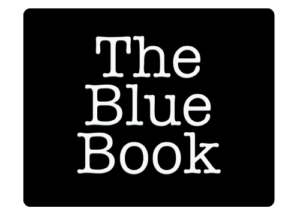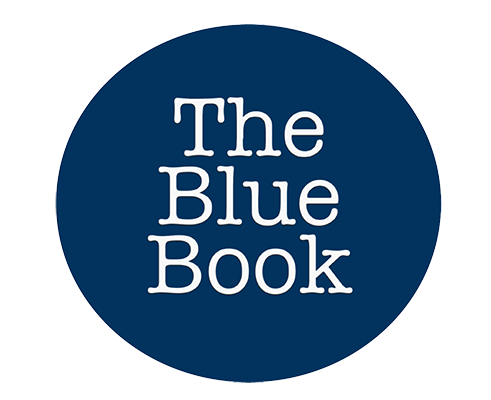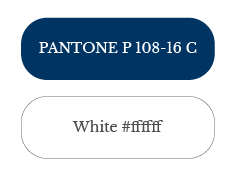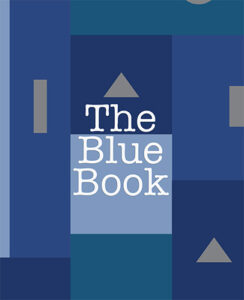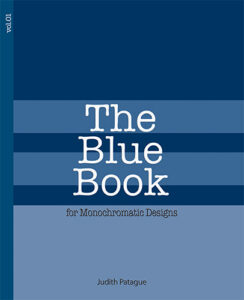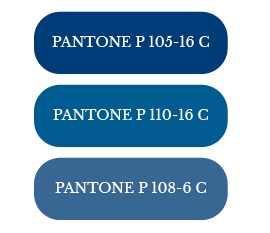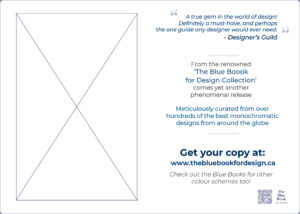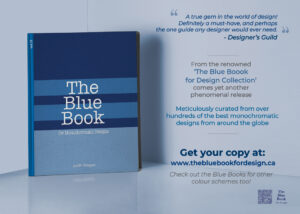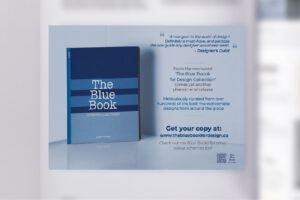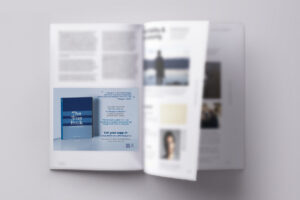The Blue Book Magazine Ad (2022)
Brand Identity | Colour Theory | Visual Composition & Layout | Typography
Design Brief | Logo Development | Book Cover | Magazine Ad | Design Rationale | Reflection
Project role:
Graphic Designer (Individual class project)
- Created all project deliverables: designed the layout; created logo graphics; sourced and edited raster images; sourced and applied typefaces/fonts and colour schemes
Program used:
Adobe Photoshop, Adobe InDesign
Key skills demonstrated:
Strategic creation and use of colour, typography, imagery, and layout | Brand identity | Creative thinking | Visual problem-solving | Visual communication
For the final project during my Colour Theory class (MDIA 1140) at BCIT, each student was given a unique design brief to work on, meaning not one of us has the same exact set of instructions to meet the project requirements. In my case, I was tasked to promote a book of my own choosing (real or fictitious) through a magazine ad. I decided to go for a fictitious book I named 'The Blue Book', which specifically delves on 'Monochromatic Designs', as I also had to depict a monochromatic colour scheme for my design.
Design Brief
About the Company
- Company Name: The Blue Book
- Service(s) or products: Book series for designers
- Mood: Blue colour theme; professional but inviting
Target Market/Audience
- Age: Mainly adults 18 and up
- Gender: All
- Price Range: Mid-range
- Demographic: Designers (mostly visual designers like graphic and web designers) or artists and painters, from all over the world regardless of race, nationality, social class, etc.
Project Goals & Objectives
- To promote the sale of the book ‘The Blue Book for Monochromatic Designs’ (via a magazine ad)
Key Project Deliverables
- Company logo
- Book Cover
- Magazine ad (7” wide x 5” high), which could include the book cover but not just the cover design
- Magazine ad mockup
* Pantone PMS colours must be used for the entire layout, including at least one spot colour for coated paper (the rest could either be spot or process)
* Simultaneous contrast has to be applied to a part of the ad
Logo Development
previous | back to top | next
Design Elements
Colours
Monochromatic colour scheme
- Tints and tones of blue
- For a calm and trendy look
*PMS colours were used including at least one spot colour for coated paper, as per project instructions
Book Cover
previous | back to top | next
Initial Book Cover Design
For the book cover, I wanted the logo branding for the book company to be front and centre, essentially becoming the layout's focal point.
As I must apply 'Simultaneous Contrast' to a part of the ad, I decided to do that on the book cover design. Using Adobe Photoshop I created rectangular shapes in different shades and tints of blue, where the text in white looks much lighter on the dark blue background but looks darker on a light blue background.
Final Book Cover Design
The final book cover design is a lot more toned down than the initial one. I decided to eliminate the other shapes in grey to keep the design as monochromatic as possible. Yet I made sure 'Simultaneous Contrast' would still be apparent on the much fewer rectangular shapes in various blue colours where the text in white would appear lighter against a darker blue background and vice versa.
Pantone CMYK/Process Coated colours were applied as there are more than four colours used; otherwise, it would be too expensive to use Spot or Solid colours. Coated version was used as the ad meant to be printed on glossy paper for magazine
Design Elements
Typography
Colours
Monochromatic colour scheme
- Tints and tones of blue
- For a calm and trendy look
*PMS colours were used including at least one spot colour for coated paper, as per project instructions
Magazine Ad
previous | back to top | next
Rough
Using Adobe InDesign I laid down the typographical elements according to hierarchy.
Process CMYK Coated colours were applied except for one Spot Solid Coated swatch (as per instructions), and they were specifically used for the brand’s word mark and also the QR code beside it to make sure the colour of the brand was consistent (i.e., in lieu of the original colour of the brand).
Final Magazine Ad Design
I finalized the Comp/Final Design by combining all the design elements created from Adobe Photoshop and Adobe InDesign.
Design Elements
Typography
Colours
Monochromatic colour scheme
- Tints and tones of blue
- For a calm and trendy look
*PMS colours were used including at least one spot colour for coated paper, as per project instructions
Design Rationale
previous | back to top | next
1) Why the main colours, ie. target audience preferences/demographics, appropriateness to the nature of the product/service you are designing for?
- As I was tasked to use a monochromatic colour scheme, I used various tints and shades of blue here such as:
- Sky Blue for the background & a portion of the book cover
- Navy blue, aqua blue, and azure blue for the shapes on thebBook cover and the text
- By the nature of the book I’m advertising here, my target audience are designers (mostly visual designers like graphic and web designers) or artists, painters, etc.; mainly adults 18 and up; from all over the world regardless of race, nationality, gender, social class, etc.
- Functions of the colours used:
- Colour that evokes emotion: The predominant use of blue colour brings about calmness and peace.
- Colour that attracts the eyes: The stark contrast between the more saturated blue on the book cover against the background is eye-catching.
- Colour that organizes content: The texts in blue signify the more important information, setting them apart from the ones in black/dark grey.
2) The 6 levels of Frank Mahnke’s human response to colour
A. Biological Reactions to a Colour Stimulus
-
- Blue colour: perceived as calming; prompts meditative thinking
B. Collective Unconscious
-
- Blue colour: Reminiscent of nature, such as water & sky; heavenly
C. Conscious Symbolism – Associations
-
- Blue colour: Symbolizes ‘peace’
D. Cultural Influences and Mannerisms
-
- Blue colour: In France, it is associated with ‘Freedom’ & ‘Peace’. In the US, it is associated with ‘Trust’
E. Influence of Trends, Fashion, Styles
-
- Blue colour: Named as the ‘Colour of the Year 2020’ by Pantone
F. Personal Relationship
-
- Blue colour: Most common favourite colour according to statistics
3) What is the focal point?
- The primary focal point is the book itself, followed by the call-to-action text saying ‘Get your copy at: www.thebluebookfordesign.ca.’
4) Type(s) of Contrast used to portray the focal point
- I used contrast of value, saturation, and size to bring out the primary focal point.
- The use of more saturated blue colours on the book cover, being the focal point, is because:
- For audience preference, it symbolizes dependability and stability;
- It’s appropriate for the nature/mood of the product, as per the title itself
- ‘The Blue Book for Monochromatic Designs’, which serves as an up-to-date guide about designs for designers.
5) What type of Harmony/Balance used?
- I used asymmetrical balance for a modern feel to the layout
- Other types of harmony used were similarity and order, pertaining to the monochromatic colour scheme
5) Any optical illusions used such as Bezold Effect or Simultaneous Contrast?
- Yes, as I applied a Simultaneous Contrast on the book cover where you’ll see rectangular shapes in different shades and tints of blue. In effect, the text in white looks much lighter on a dark blue background but looks darker on a light blue background.
Reflection
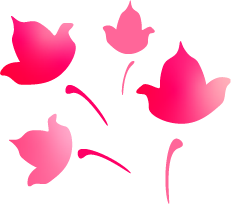
During my Colour Theory Class I got to learn various colour models such as RGB, CMYK, and HSB. And as a bonus module, the Pantone colour system was also expounded on for our final project. Although getting to work on a whole different kind of colour system was a bit of a learning curve for me, I was grateful to have been taught effective methods on applying Pantone colours in the Adobe Creative Suite programs. I could see how such knowledge would be crucial in bringing about colour accuracy and ink optimization in printed designs and materials in real-life application.
The design brief I got was overall straightforward with a little bit of twist such as making sure the entire layout adheres to a monochromatic colour scheme, and demonstrates a simultaneous contrast optical illusion on a certain portion of it. Choosing blue as the main colour for my design was an easy decision having known for a fact that majority of people leans toward it. And for the simultaneous contrast, the white colour on the brand’s word mark would appear lighter or darker if I place it against different shades of blue.
The result of this project was a huge success having garnered a grade of 95% for it. But more importantly, acquiring the knowledge and skills for an important aspect of the prepress and print process in graphic design was truly valuable and definitely something I would be able to apply in actual projects in the future.

